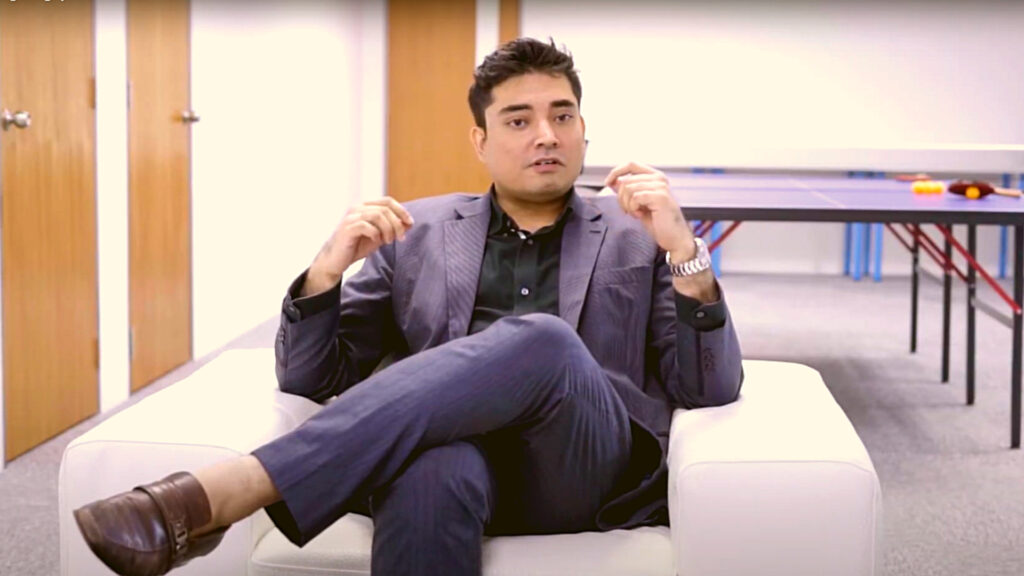Sancy Suraj is a name that is synonymous with memory sports. His incredible achievements at the World Memory Championships have earned him worldwide recognition as one of the best memory athletes in the world. Suraj represented Singapore at the 2011 World Memory Championships held in Guangzhou, China, where he memorized an impressive 176 abstract images in 15 minutes, 98 words in 15 minutes, 480 numbers in 60 minutes, 51 names, and faces in 15 minutes, and 460 binary digits in 30 minutes.
In this article titled “From Abstract Images to Names: Sancy Suraj’s Winning Strategies at the World Memory Championships,” we speak to Sancy Suraj himself about his specific strategies and techniques used to memorize different types of information, how he decides which memory techniques to use for each type of information, and how he adapts his strategies on the fly during competitions.

Can you walk us through some of the specific strategies you used to memorize different types of information, such as abstract images, names, and numbers, during the World Memory Championships?
Absolutely, I’d be happy to share some of the strategies I used to memorize different types of information during the World Memory Championships.
Firstly, when it came to memorizing abstract images, I utilized a technique known as the “Story Method”. This technique involves creating a memorable story that connects all of the images together in a logical sequence. For example, if I was given the images of a butterfly, a hammer, and a tree, I would create a story in my mind where a butterfly is flying and lands on a hammer, which is then used to chop down a tree. This allows me to easily recall the images in the correct order.
When it came to memorizing names and faces, I used a technique called the “Link Method”. This involves creating a link or association between the name and a visual image. For example, if I had to remember the name “John”, I would associate it with an image of a toilet “john” and visualize John sitting on the toilet. This creates a strong visual link in my mind that helps me recall the name when I see the face.
Lastly, for memorizing numbers, I used a technique known as the “PAO System”. This system involves creating a three-part image for each digit, with the first part representing a person, the second part representing an action, and the third part representing an object. For example, the number 123 might be represented as a person (1) juggling (2) three (3) balls. By creating these vivid and memorable images for each number, I am able to quickly recall long strings of digits.
Overall, these techniques require a lot of practice and repetition to become proficient, but with time and dedication, they can be incredibly effective for memorizing all types of information.
How do you decide which memory techniques to use for each type of information, and how do you adapt your strategies on the fly during the competition?
When it comes to deciding which memory techniques to use for each type of information, it all depends on the individual’s strengths and weaknesses. For example, I personally find that I am better at remembering visual images than I am at remembering numbers, so I tend to use the Story Method more for abstract images and the PAO System more for numbers. However, this is not always the case for everyone, and it’s important to experiment with different techniques to find what works best for you.
During the competition, it’s important to be able to adapt your strategies on the fly based on the specific type of information you are given. For example, if I find that I am struggling to remember a particular sequence of numbers using the PAO System, I may switch to a different technique like the Major System, which involves associating each digit with a consonant sound and then forming words or phrases with those sounds.
Another key factor in adapting strategies during the competition is time management. Each event has a specific time limit, so it’s important to be able to quickly assess which technique will be most effective for the given information and then execute it efficiently within the allotted time. This requires a lot of practice and experience, as well as the ability to remain calm and focused under pressure.
In the end, the key to success in memory competitions is not just having a strong arsenal of memory techniques, but also the ability to adapt and improvise based on the specific challenges presented. With practice and dedication, anyone can become a skilled memory athlete and achieve great results in these competitions.
Were there any particular items that you found especially challenging to memorize during the competition, and how did you overcome those challenges?
Yes, there were definitely some items that I found especially challenging to memorize during the competition. One of the most difficult events for me was the random words event, where I had to memorize as many words as possible in 15 minutes. This was challenging because there is no inherent structure or pattern to the words, which made it difficult to create meaningful associations between them.
To overcome this challenge, I relied on a technique known as the “Loci Method”, which involves mentally placing each word in a specific location within a familiar setting, such as a house or a park. By visualizing each word in a specific location, I was able to create a memorable association between the word and its location, which helped me recall the words in the correct order.
Another challenging event for me was the names and faces event, where I had to memorize as many names and faces as possible in 15 minutes. This was challenging because there are so many individual details to remember for each person, such as their name, face, occupation, and hobbies.
To overcome this challenge, I used a technique called the “Person-Action-Object Method”, which involves associating each person with a specific action and object. For example, if I had to remember the name and face of a person who was a doctor and enjoyed playing golf, I would associate them with the action of giving a golf lesson and the object of a golf club. This helped me create memorable associations for each person that allowed me to quickly recall their name and face.
In the end, overcoming these challenges required a lot of practice and experimentation with different memory techniques. By constantly pushing myself to improve and adapting my strategies based on the specific challenges presented, I was able to achieve great results in the competition and become a world champion in memory sports.
“Challenges are opportunities for growth. During the competition, I faced difficult tasks like memorizing random words and names with faces. But by employing memory techniques like the Loci Method and Person-Action-Object Method, I turned those challenges into triumphs. It’s a reminder that with practice and perseverance, we can overcome any obstacle and achieve remarkable success.”
What role do mental and physical preparation play in memory sports competitions like the World Memory Championships, and how did you prepare yourself for the event?
Both mental and physical preparation play a crucial role in memory sports competitions like the World Memory Championships. On the mental side, it’s important to have a strong focus and concentration, as well as the ability to stay calm under pressure. Memory competitions can be mentally exhausting, and it’s essential to be able to maintain a high level of mental energy throughout the competition.
To prepare myself mentally, I would spend several hours each day practicing my memory techniques and working on improving my focus and concentration. I also used visualization and meditation techniques to help me stay calm and centered during the competition.
On the physical side, it’s important to be in good physical shape to perform at your best in memory competitions. Physical exercise helps increase blood flow to the brain, which can improve cognitive function and memory retention.
To prepare myself physically, I made sure to maintain a healthy diet and exercise regularly leading up to the competition. I would also take breaks during my practice sessions to stretch and move my body, which helped keep me energized and focused.
In addition to mental and physical preparation, it’s also important to have a strong support system of coaches, mentors, and fellow memory athletes. I would often consult with other memory athletes and attend workshops and seminars to learn new techniques and strategies for improving my memory.
Overall, preparation is key to success in memory sports competitions like the World Memory Championships. By focusing on both mental and physical preparation and surrounding myself with a supportive community, I was able to achieve great results in the competition and become a world champion in memory sports.
What is your approach to balancing speed and accuracy in memory sports, and how do you avoid making mistakes while memorizing large amounts of information under time pressure?
In memory sports competitions like the World Memory Championships, balancing speed and accuracy is crucial. It’s important to memorize as much information as possible within the given time limit while minimizing mistakes. To do this, I have developed a specific approach that helps me achieve the right balance between speed and accuracy.
First and foremost, I focus on mastering my memory techniques so that I can use them quickly and efficiently. This allows me to quickly encode and store large amounts of information in my memory. At the same time, I pay close attention to the details and try to be as accurate as possible in my memorization.
Another strategy I use is to break down the information into smaller chunks and memorize them in a structured way. This helps me avoid confusion and mistakes that can occur when trying to memorize too much information at once.
During the competition, I also make sure to pace myself and avoid rushing. While it’s important to work quickly, it’s equally important to take the time to double-check my work and make sure that I haven’t made any mistakes.
To avoid mistakes, I also try to stay calm and focused during the competition. I use breathing techniques and visualization exercises to help me stay centered and avoid getting overwhelmed by the pressure of the competition.
Overall, my approach to balancing speed and accuracy in memory sports involves mastering memory techniques, breaking down information into smaller chunks, pacing myself, and staying calm and focused under pressure. By using these strategies, I am able to achieve high levels of performance in memory sports competitions.
“Speed and accuracy are the twin pillars of success in memory sports. I approach it with a well-honed technique, structured memorization, and mindful pacing. Staying calm under pressure and double-checking my work keeps mistakes at bay. It’s all about finding the perfect balance between speed and accuracy to achieve peak performance in the world of memory sports.”
Sancy Suraj’s incredible memory abilities are based on a wide range of techniques and strategies that he has developed over the years. In response to the question regarding his specific strategies for memorizing different types of information, Suraj discusses how he uses visualizations, associations, and other mnemonic devices to help him remember information more effectively. He also talks about how he adapts his strategies on the fly during competitions, depending on the specific type of information he is trying to memorize.
When asked about the most challenging items to memorize during the competition, Suraj reveals that it was names and faces. However, he overcame this challenge by creating vivid visualizations and associating the names with specific images, which helped him recall the information more easily.
In terms of mental and physical preparation, Suraj stresses the importance of regular training and practice. He discusses how he spends hours every day training his memory and how he incorporates physical exercise and healthy eating habits to maintain his mental and physical fitness.
Regarding balancing speed and accuracy, Suraj emphasizes the importance of striking a balance between the two. He notes that accuracy is more important than speed, as making mistakes can be costly in memory sports competitions. He also talks about how he avoids making mistakes by using memory techniques that allow him to check his work as he goes.
How do you plan to continue refining and improving your memory strategies in the future, and what are your goals for future memory sports competitions?

As a memory athlete, I believe that there is always room for improvement, and I am constantly looking for new ways to refine and enhance my memory strategies. One of the key ways I plan to continue improving is by experimenting with new memory techniques and approaches. By trying out different methods and seeing how they work in practice, I hope to discover new ways to improve my performance in memory sports competitions.
Another way I plan to improve is by continuing to train consistently and regularly. Memory sports require a lot of practice and dedication, and I plan to continue training my memory regularly to maintain my skills and improve my speed and accuracy.
In terms of goals for future memory sports competitions, my ultimate aim is to continue to compete at the highest level and achieve even greater levels of success. I am always striving to improve my performance and push the limits of what I am capable of achieving.
In addition to competing, I also hope to use my memory skills to benefit others. For example, I would like to develop and teach memory techniques to help people with memory-related challenges, such as those suffering from dementia or other memory-related conditions.
Overall, my plan for the future is to continue refining and improving my memory strategies while also using my skills to make a positive impact in the world. Whether through competition or teaching, I hope to continue pushing the boundaries of what is possible with the power of memory.
“Constantly refining my memory strategies and pushing the boundaries of what’s possible is my driving force. I strive to improve my performance, compete at the highest level, and make a positive impact with my memory skills. The journey to unlock the full potential of my memory is an ongoing pursuit, and I’m committed to pushing myself to new heights in future memory sports competitions.”
Sancy Suraj’s remarkable achievements at the World Memory Championships are a testament to his incredible memory skills and dedication to the art of memory. His unique strategies and techniques have allowed him to memorize vast amounts of information quickly and accurately, placing him among the world’s best memory athletes. As he continues to refine and improve his strategies, Suraj plans to use his skills to benefit others by developing and teaching memory techniques to those in need. We look forward to seeing what the future holds for this incredible memory athlete.






























